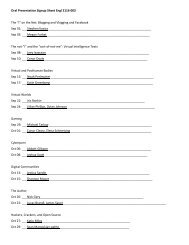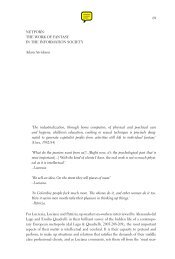Nakamura, Digitizing Race, Introduction, chapter 5, Epilogue
Nakamura, Digitizing Race, Introduction, chapter 5, Epilogue
Nakamura, Digitizing Race, Introduction, chapter 5, Epilogue
You also want an ePaper? Increase the reach of your titles
YUMPU automatically turns print PDFs into web optimized ePapers that Google loves.
88 Alllooksame?<br />
the point that Western media are not the threat to the Walpiri; rather, the<br />
“newly constructed, media-simulated Aboriginality, delivered as content by<br />
AUSSAT satellite to the remote communities, can succeed at subverting<br />
their traditions in a way that no other invasion has. It is not, then, through<br />
the dumping of European content to these locations but through the transmission<br />
of a powerful competing Aboriginal image, appropriated from the<br />
bush, purchased at the expense of local media, and filtered through the grid<br />
of a manufactured history that culturecide could readily be accomplished.” 36<br />
His claim has far-reaching consequences, for it posits that a compromised<br />
type of aboriginal new media production might prove more destructive to<br />
native culture than any outside influence. The appropriation and transmission<br />
of a false, manufactured, inauthentic type of nativism through cyberspace,<br />
potentially a more global medium than even television, has the potential<br />
for immense harm.<br />
On the other hand, many new media collectives in traditionally “mediapoor”<br />
countries who lack widespread access to the Internet strongly assert<br />
the usefulness of Internet and computer use in the context of non-Western<br />
culture. New Media Centre Sarai in Delhi is trying to make software for<br />
people who are nonliterate as a means to wrest the medium away from cultural<br />
elites. 37 Even more importantly, this move away from textual literacy<br />
produces expressive forms that are more in line with the culture’s distinctive<br />
media landscape, thus reducing the dangers of imperializing incursions<br />
from the West. Jeebesh Bagchi, a Sarai member and a Raqs Media Collective<br />
artist, claims that “India is a song and visual sign board culture” and<br />
asks, “What kind of dialogue with this strange and eclectic world do we<br />
want to create, not based on domination or populism?” 38 Envisioning and<br />
using the Internet in visual rather than primarily textual ways can be a radically<br />
empowering move for nonliterate groups.<br />
Seen in this light, the Internet has tremendous potential for challenging<br />
colonial regimes of power, particularly those that privilege access to the<br />
written word. Sarai asserts that the Internet need not be a manifestation of<br />
the West’s darker side but can be retooled as an empowering device for non-<br />
Western users. Sarai’s emphasis on reaching nonliterate users acknowledges<br />
the power dynamics associated with literacy. Before there was a digital divide,<br />
questions of power had always worked themselves out in the written-word<br />
divide. New electronic mediations that will successfully reach the “people”<br />
may do so by detouring around the written word, a particularly appropriate<br />
tactic in visual cultures such as India’s. As Bagchi explains: “So far in India





